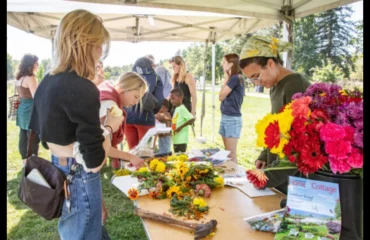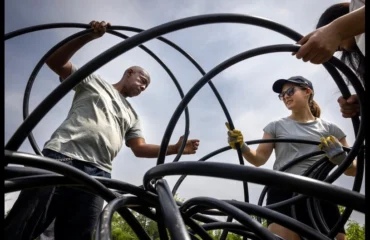Michigan’s World Class
Students earning credit for creating cell phone learning apps for Singapore 3rd graders.
A course in which students visit habitats, collect samples and observe interactions in nature, in order to understand environmental challenges.
Faculty who take students to Detroit to figure out a watering system for a community garden, engage children in the arts and help a non-profit group with a business problem.
These are just some of the ways teaching and learning happen at the University of Michigan. The stories of life-changing classroom experiences, inspiring faculty members, and students itching to roll up their sleeves and work on societal problems are the focus of a new series at U-M.
Michigan’s World Class celebrates teaching and learning at U-M by telling stories of how schools and colleges and, more importantly, the faculty in them, are challenging today’s students in new ways.
“We’re in a moment of critical change in the ways that higher education works for our students,” says Phil Deloria, associate dean for undergraduate education in the College of Literature, Science and the Arts.
“Teaching is absolutely central to life at the University of Michigan. It connects with the research mission. It connects with our mission to the state, the nation and the world. It connects up to our desire to innovate and create new possibilities, and to take the knowledge that we have, and convey it, make it useful, useable and wonderful for the next generation,” says Deloria, who also is the Carroll Smith-Rosenberg Collegiate Professor of History and American Culture. “It’s really the heart of everything we do; it’s why we are here.”
Teaching takes many forms at U-M, ranging from the classic lecture to courses that use the latest and greatest technology, not only to engage students but track and measure their success.
A number of U-M faculty are “flipping classroom,” offering lectures online so that class time can be spent in discussion and problem solving, leading to better understanding of the ideas and a better ability to use those ideas. Still others are matching students with people and organizations to work on projects in attempt to help address real problems.
“What we have to do is move our students from lower order thinking skills, which are about producing content, into higher order thinking skills, which are about synthesis and creativity. And one of the best tools that we have to do that is to bring them into an immersive, hands-on or action based situation.” Deloria says.
Provost Phil Hanlon agrees, noting additional ways students are learning today, including engaging with faculty in their research; participating in service learning, entrepreneurial activities, creative performance and clinical placements; and taking advantage of travel abroad experiences.
“The future I see is that the balance between that kind of active learning and passive learning in the classroom is going to have to shift considerably to the active learning side. So we’re going to be doing more situations with students in small groups, who, together with faculty, are actually grappling with complex problems in the world,” Hanlon says.
He adds that U-M has a long history of preparing leaders in its twofold mission of advancing knowledge to solve world problems, and educating and preparing leaders to go out and change the world.
“Beyond the traditional skills that go with a University of Michigan education, an additional set of skill have achieved a new level of importance. Those are things like learning how to take risks in a complex environment, learning to work well with people who are from very different backgrounds and perspectives, and being able to work comfortably in settings, which are unlike anything you’ve ever seen,” says Hanlon, who also is the Donald J Lewis Collegiate Professor of Mathematics, and in Fall 2012 taught a course on the university budget process.
The immersive learning experience is at the heart of much of the curriculum in the College of Engineering, where from the first introductory course students engage with hands-on, often client-based experiences, and hundreds of students from schools and colleges across campus come together on projects like the solar car.
“A lot of learning happens when students engage with the material, when they try it out, when they try and use ideas that they’ve learned from a classroom or learned from reading a textbook,” says James Holloway, associate dean of engineering, Thurnau Professor and professor of nuclear engineering and radiological sciences. “Learning happens when they work together, and when they work on an authentic project, where there’s a real deliverable.”
Much of the shift in teaching and learning is related to advances in technology. The leaders all agree student immersion into technology leads to greater expectations that it will be a part of their learning experience. But there are additional reasons for the changing face of education today.
Constance Cook, associate provost and director of the Center for Research on Learning and Teaching, says research has led to greater understanding of the way the brain works and how learning occurs.
“Faculty have benefitted from that kind of research. They now understand that lectures do not lead to the deep learning that they are hoping students will achieve. That if you have action-based, immersive, engaged learning for students, they are more likely to learn critical thinking and creativity skills. They are more likely to be innovative as they graduate from this university.”
Cook adds that CRLT focuses on providing support for faculty to adapt to the changing needs of today’s diverse student body.
“There are lots of funds for faculty who want to do innovative projects with their students, and there are plenty of programs about teaching strategies, with faculty colleagues offering examples. CRLT and other offices provide inspiration and guidance – both in person and on the web. And we see at this university many faculty who take good advantage of these opportunities,” Cook says.
Programs offered to faculty include grant funding to try out new approaches and technology, to take students on trips, or to pay for outside speakers and other activities; programs that bring faculty together to share experiences and ideas; and programs that showcase excellence, including the Thurnau Professorships and the Provost’s Teaching Innovation Prize.
In addition, LSA offers support for its faculty, including Teaching Transformed Grants, which help a senior faculty member who wants to integrate new methods into the classroom but needs a technical expert to work alongside him or her for a time.
Hanlon also points to the new Third Century Initiative, launched a year ago, which includes allocating $50 million over five years for the development of innovative student learning experiences and creative approaches to the world’s greatest challenges and opportunities. The Provost’s Office recently called for new proposals for the initiative.
“We have significant funding available to pilot new things, to try new things, to help faculty follow and develop their ideas,” Hanlon says.
The leaders say overall faculty at U-M have embraced the changing classroom environment.
“Faculty have learned to engage in that kind of active learning technique in their classrooms, but they’ve also learned how to create environments and experiences for students that are outside the classroom. And so our faculty are engaged in everything from classroom teaching to mentoring student projects to helping students find ways to study abroad,” Holloway says, adding that, like Hanlon, he sees a future in 10 years of even more action-based learning.
“We’re going to see students who come to a place like Ann Arbor for the richness of the educational and intellectual environment, and we’re going to prepare them to actually go out and work in the wider world.”


